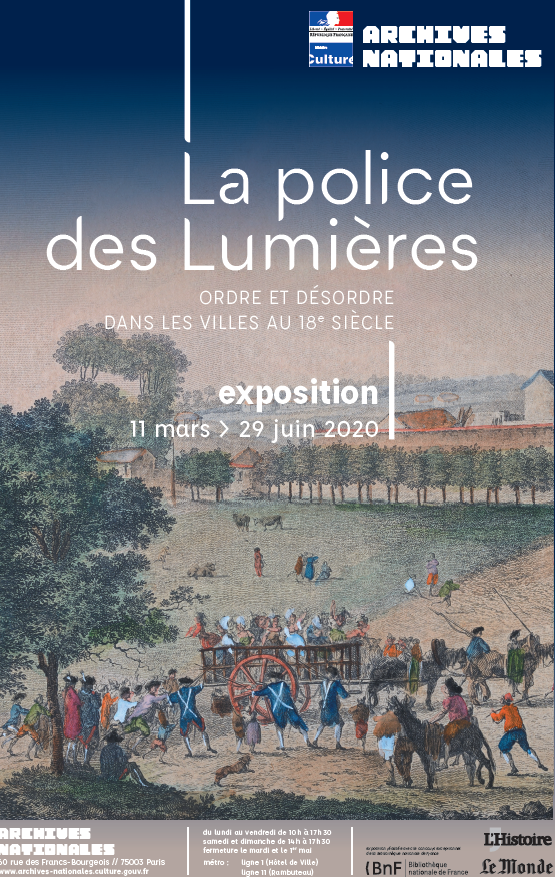Colin Jones writes:
The British have long held a very negative view of Parisian policing in the eighteenth century. The episode in which the duchess of Elbeuf lost her freedom (and indeed the correspondence notebooks at the centre of this project) when she was denounced to her neighbourhood’s surveillance committee at the height of the Terror in early 1794, seems to endorse this opinion. Even before counter-revolutionary propaganda during the Revolutionary and Napoleonic wars had painted the Paris police in grimly lurid colours – later popularised in literary offerings such as Charles Dickens’ Tale of Two Cities and baroness d’Orczy’s The Scarlet Pimpernel – it had long attracted vociferous British criticism. Parisian police spies, censors, lettres de cachet, and all the rest caused shudders in preening ‘Free-Born Englishmen’. Some even doubted that the ‘police’ was a bona fide word in English: it was, Dr Johnson’s dictionary sagaciously observed, ‘a French term’.
 One of the striking effects of the exhibition, ‘La Police des Lumières: ordre et désordre dans les villes au XVIIIe siècle’(‘The Police during the Enlightenment movement: urban order and disorder during the eighteenth century’), is to complicate and revise this simplistic vision. In that century, the French term ‘la police’ encompassed far more than our modern, narrow understanding of policing: it signified a desire for sound administration, rational governance and urban improvement. It worked through the application of reason in ways that the philosophes and their followers could admire (and indeed some of them contributed towards its multiform activities). The aim was improvement tailored to produce a cleaner, healthier, safer, leisure-enjoying and happiness-enhancing urban environment.
One of the striking effects of the exhibition, ‘La Police des Lumières: ordre et désordre dans les villes au XVIIIe siècle’(‘The Police during the Enlightenment movement: urban order and disorder during the eighteenth century’), is to complicate and revise this simplistic vision. In that century, the French term ‘la police’ encompassed far more than our modern, narrow understanding of policing: it signified a desire for sound administration, rational governance and urban improvement. It worked through the application of reason in ways that the philosophes and their followers could admire (and indeed some of them contributed towards its multiform activities). The aim was improvement tailored to produce a cleaner, healthier, safer, leisure-enjoying and happiness-enhancing urban environment.
The exhibition of objects on display draws on much provincial material, but Paris inevitably predominates, and co-curators Vincent Denis, Isabelle Foucher and Vincent Milliot have assembled an extraordinarily wide and striking array. These highlight the intricate operational detail which Parisian policing took in its stride. But they also graphically illuminate the dark and repressive side of ‘enlightened’ police forces, particularly as regards those situated towards the bottom or on the margins of society (paupers, beggars, petty miscreants, vagrants, prostitutes, etc), and also those writers and intellectuals who were felt to be infringing the social, political and religious order.
In 1789 the Revolutionaries took a dim view of Ancien Régime policing, and sought to replace unelected with democratically elected officials whose mission was to protect individual liberties and ensure a regime of legislative transparency. This was dissipated by the outbreak of war and the move towards terror from 1792 onwards. Yet despite the reputation of the police under the Terror as an almost proto-totalitarian force, snuffing out freedom of opinion and crushing dissent, they proved unable to stop (until early 1794) the duchess of Elbeuf writing her openly counter-revolutionary letters to a friend a matter of yards from the heart of government. When it came to brutal police repression, maybe the Ancien Regime did it better after all?
——————————————————————————————————————————————
The exhibition at the Archives nationales, Hôtel de Soubise, Rue des Francs-Bourgeois, Paris, is scheduled to run until 14 January 2021. It is currently closed because of the Covid crisis. The catalogue, edited by the curators (and with a brief introduction by the present author) is available from Gallimard: La police des Lumières. Ordre et désordre dans les villes au XVIIIᵉ siècle (2020).
